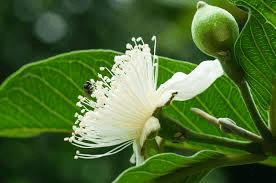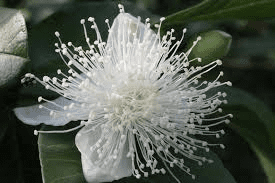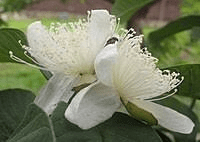Guava sepals are the outermost floral structures of the guava plant, which belongs to the genus Psidium in the Myrtaceae family. These sepals play a crucial role in the reproductive process of the guava plant. They are typically found at the base of the flower and encase the developing fruit before it ripens.
The primary function of guava sepals is to protect the flower bud as it develops. They are often green and leaf-like, providing a protective layer that shields the more delicate flower parts from environmental stressors such as excessive sunlight, rain, and pests. As the flower matures and begins to bloom, the sepals usually remain attached and continue to provide support to the flower.
In terms of structure, guava sepals are usually arranged in a whorl at the base of the flower. They can vary in number, shape, and size depending on the guava variety. Typically, there are five sepals, but this number can vary. Each sepal is composed of several layers of cells, including an outer epidermal layer and an inner layer of parenchyma cells. The epidermal layer often features a waxy cuticle that helps reduce water loss and provides a barrier against pathogens.
The sepal’s cell structure contributes to its ability to protect the flower bud. The epidermal cells are generally more resistant to mechanical damage and environmental factors, while the inner parenchyma cells provide additional support and flexibility. The arrangement and thickness of these cells can influence the sepal’s durability and its ability to shield the developing flower.
As the flower transitions to fruit, the sepals often undergo changes. They may become more rigid and persistent, remaining attached to the fruit even after flowering has concluded. This persistence is significant as it can help protect the developing guava from external damage and can play a role in the fruit’s overall development and quality. In some guava varieties, the sepals might also become more prominent and showy, contributing to the fruit’s visual appeal.
Environmental factors and growing conditions can also impact the development and health of guava sepals. For instance, inadequate water or nutrient deficiencies can result in malformed or weak sepals that may not offer sufficient protection to the developing fruit. On the other hand, optimal growing conditions can enhance the strength and functionality of the sepals, supporting better flower and fruit development.
In summary, guava sepals are vital floral structures that protect the flower bud and support the fruit’s development. Their structure, including the epidermal and parenchyma cell layers, plays a key role in their protective function. Understanding the role and development of guava sepals can provide valuable insights into the plant’s reproductive health and overall fruit quality.
The Economic Importance and Uses of Guava Sepals

1. Herbal Medicine: Guava sepals are used in traditional medicine for their potential therapeutic properties, such as treating respiratory issues and inflammation.
2. Natural Dyes: The pigments in guava sepals can be extracted and used as natural dyes for textiles and crafts.
3. Composting Material: Guava sepals can be composted to enrich the soil with organic matter and nutrients.
4. Mulch: Shredded guava sepals are used as mulch to retain soil moisture and suppress weed growth.
5. Potpourri: Dried guava sepals are used in potpourri for their natural fragrance.
6. Skincare Products: Extracts from guava sepals are used in skincare products for their antioxidant and anti-inflammatory properties.
7. Animal Feed: Guava sepals can be used as supplementary feed for livestock, especially when other feed sources are scarce.
8. Biofertilizer: Compost made from guava sepals can be used as a biofertilizer to improve soil health.
9. Natural Pest Repellent: Extracts from guava sepals can be used to create natural pest repellents for crops.
10. Charcoal Production: Guava sepals can be converted into charcoal, which is used as a fuel and in various industrial applications.
11. Craft Materials: The sepals are used in crafting to create decorative items and art.
12. Eco-friendly Packaging: Guava sepals can be processed into biodegradable packaging materials.
13. Soil Erosion Control: Guava sepals are used in projects to control soil erosion and stabilize land.
14. Biomass Energy: They can be used as biomass for generating renewable energy.
15. Fertilizer Additive: Guava sepals are added to fertilizers to boost nutrient content.
16. Animal Bedding: Dried sepals can be used as bedding material for livestock.
17. Environmental Conservation: Guava sepals help in environmental conservation by contributing to soil health and erosion control.
18. Artistic Uses: Guava sepals are used in artistic projects and crafts for their unique appearance.
Read Also: Toyger Cat Breed Description and Complete Care Guide
The Products and By-products That Can Be Derived From Guava Sepals

1. Natural Dyes: Pigments from guava sepals are extracted for use as natural dyes.
2. Compost: Guava sepals are composted to produce nutrient-rich compost for soil improvement.
3. Mulch: Shredded sepals are used as mulch to conserve soil moisture and control weeds.
4. Potpourri: Dried sepals are used in potpourri mixes for their aroma.
5. Skincare Products: Extracts from guava sepals are incorporated into creams and lotions for their skin benefits.
6. Animal Feed: Sepals are used in feed mixtures for livestock.
7. Biofertilizer: Compost made from guava sepals is used as a biofertilizer.
8. Natural Pest Repellents: Extracts are used to make natural pest repellents.
9. Charcoal: Sepals can be carbonized to produce charcoal for fuel.
10. Craft Materials: Guava sepals are used in crafting and decorative projects.
11. Eco-friendly Packaging: Processed sepals are used in biodegradable packaging.
12. Soil Erosion Control: Guava sepals are used to prevent soil erosion and stabilize land.
13. Biomass Energy: Sepals are used as biomass for renewable energy generation.
14. Fertilizer Additive: Guava sepals are added to fertilizers to enhance their nutrient content.
15. Animal Bedding: Dried sepals are used as bedding for livestock.
16. Environmental Projects: Sepals contribute to environmental conservation efforts.
17. Artistic Projects: Guava sepals are used in art and craft projects for their aesthetic qualities.
18. Soil Conditioner: Guava sepals are used as soil conditioners to improve soil structure and fertility.
Read Also: Are Honey Bees Aggressive?
Frequently Asked Questions (FAQ’s) About Guava Sepals

1. What are the uses of guava sepals in traditional medicine?
Guava sepals are used to treat respiratory issues, inflammation, and other health conditions in traditional medicine.
2. How can guava sepals be used as natural dyes?
Pigments from guava sepals are extracted and used to dye textiles and crafts.
3. Can guava sepals be used in composting?
Yes, guava sepals can be composted to enrich soil with organic matter and nutrients.
4. How are guava sepals used in skincare products?
Extracts from guava sepals are incorporated into skincare products for their antioxidant and anti-inflammatory benefits.
5. Are guava sepals effective as a natural pest repellent?
Yes, extracts from guava sepals can be used to create natural pest repellents for crops.
6. Can guava sepals be used for energy production?
Yes, they can be used as biomass for generating renewable energy or processed into charcoal.
7. How are guava sepals used in crafting?
Guava sepals are used to create decorative items and art due to their unique appearance.
8. What is the role of guava sepals in soil erosion control?
They are used in projects to stabilize soil and prevent erosion.
9. How can guava sepals be used in eco-friendly packaging?
Processed guava sepals are used to create biodegradable packaging materials.
10. Can guava sepals be used as animal feed?
Yes, guava sepals can be used as supplementary feed for livestock.
Read Also: Complete Composting Guide for Beginner

